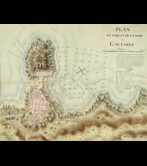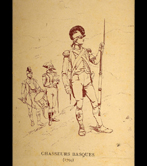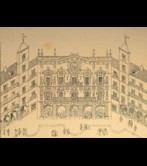The Convention in San Sebastián
On 7th March 1793, the French Convention declared war on Bourbon Spain. It was the culmination of several months of tension, during which time the Junta General had been strengthening and fortifying the border. When French troops entered Spain in April, the wall and castle at San Sebastián were demolished so that the cannons could be used to defend Bidasoa, where the progress of the French was halted briefly. But in August the French entered Navarra and took Irun and Hondarribia. The Provincial Council fled San Sebastián for Getaria. The French advanced and, even though the entire province had not been occupied, the defenceless San Sebastián capitulated on 4th August 1794. The city's surrender, with no military defence, led Godoy (a minister of Carlos IV) to claim that an understanding existed between Gipuzkoa and the French. By way of evidence he alleged that San Sebastián had trading, cultural and even political links with France. These accusations were strengthened by the fact that the province became a factor in the demands made during the talks that were held to bring an end to the conflict.
On 14th August, the Junta General met in Getaria and drafted an agreement with France by which Gipuzkoa would be constituted as a free and neutral state under the protection of the Republic of France. The French would not force Gipuzkoa to hand over its arms, nor meddle in its matters of government. In exchange, the province would collaborate with French troops. Though at first it seemed that the Convention would accept the agreement, in the end they merely offered to admit Gipuzkoa as an integral part of the Republic of France. The Convention’s refusal led to Gipuzkoa being treated as a conquered country. Furthermore, the representatives of the Convention dissolved the Junta in Getaria, imprisoned several of its members and replaced the consistory of San Sebastián with a 12-man commission, only one of whom was from the city.
As a result of the conquest of the city, numerous inhabitants abandoned their houses and fled. Meanwhile, the French requisitioned goods, forced shops to open to guarantee supplies for their troops, arrested members of the clergy and closed down churches and monasteries. In April 1795, a number of town councils that had been suspended were allowed to recommence their activities, though they continued to be monitored by a French-run higher administration. This situation continued until the Peace of Basel was signed on 22nd July, and duly declared on 5th September 1795.
However, the consequences for San Sebastián were not over when the war ended. Godoy's accusations that the city had connived with the French in the capitulation of August 1794 resulted in a military trial being held in Pamplona. The officers and heads of the San Sebastián garrison were arrested, together with the members of the 1794 corporation, as well as many of the city’s inhabitants; the accused received sentences ranging from banishment to exile, lifelong prohibition from holding municipal posts, courts martial (in the case of the soldiers), jail sentences and even a hanging – of the San Sebastián fugitive José Javier Urbiztondo.




